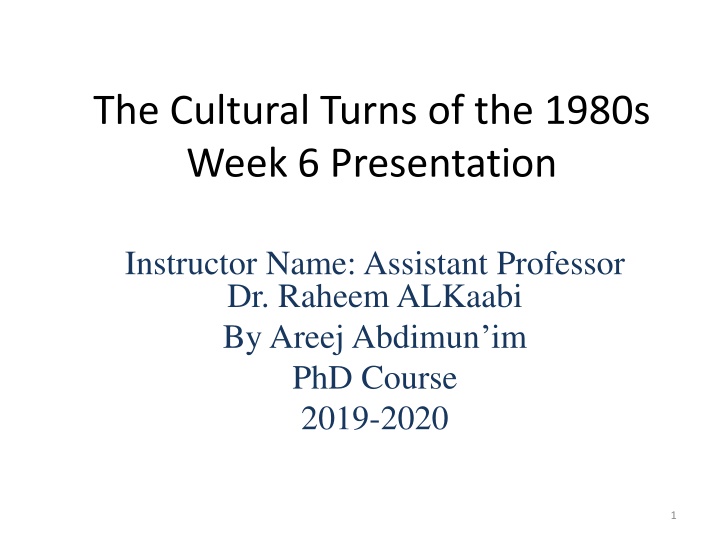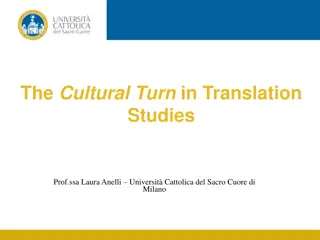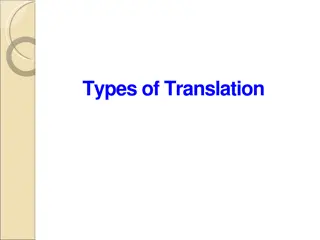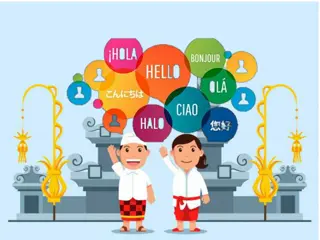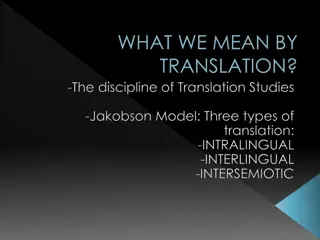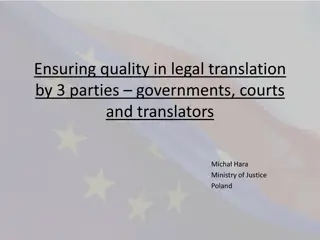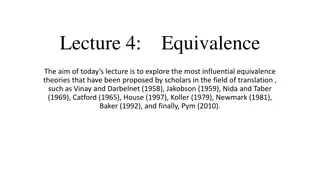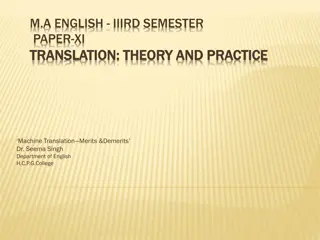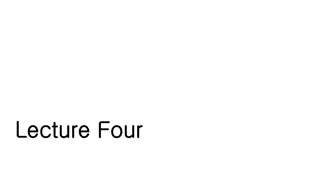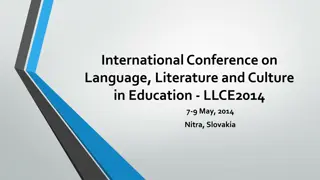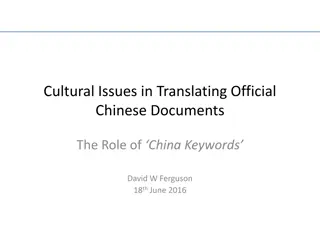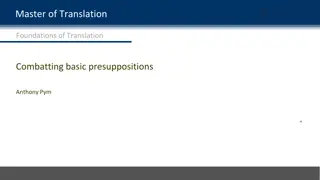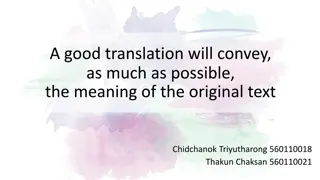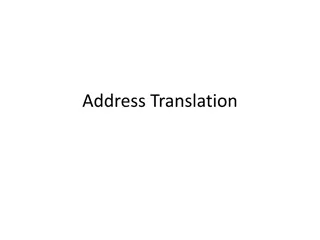The Cultural Turns of the 1980s in Translation Studies
This presentation explores the various cultural turns in Translation Studies during the 1980s, highlighting key scholars such as Snell-Hornby and Even-Zohar. It discusses the linguistic turn, pragmatic turn, and the significance of cultural studies in understanding translation processes, particularly in the context of China. The introduction touches on Descriptive Translation Studies and the Manipulation School, shedding light on the evolving paradigms within literary translation research.
Download Presentation

Please find below an Image/Link to download the presentation.
The content on the website is provided AS IS for your information and personal use only. It may not be sold, licensed, or shared on other websites without obtaining consent from the author.If you encounter any issues during the download, it is possible that the publisher has removed the file from their server.
You are allowed to download the files provided on this website for personal or commercial use, subject to the condition that they are used lawfully. All files are the property of their respective owners.
The content on the website is provided AS IS for your information and personal use only. It may not be sold, licensed, or shared on other websites without obtaining consent from the author.
E N D
Presentation Transcript
The Cultural Turns of the 1980s Week 6 Presentation Instructor Name: Assistant Professor Dr. Raheem ALKaabi By Areej Abdimun im PhD Course 2019-2020 1
This chapter traces the course of the cultural turn in Translation Studies during the 1980s . Contemporary translation studies have seen a great number of turns, such as linguistic turn, pragmatic turn, cultural turn, translation turn, power turn and fictional turn. 2
Introduction Though translation studies witnessed a lot turns, it was only Snell-Hornby who studied the turns systematically. the linguistic turn of translation studies is primarily attributed to the achievements made by the scholars of linguistic school such as Roman Jacoboson, Eugene A. Nida, J. C. Caford, Peter Newmark, Basil Hatim, Mary Snell-Hornby and Mona Baker. As to the culture turn, it mainly owns to the studies by the scholars such as James Holmes, Itamar Even- Zohar, Gideon Toury, Andre Lefevere and Susan Bassnett. 3
In China, the study of translation turns began with the introduction of western translation theory 1970s. Ever since then, the study of western translation theories is like an upsurge swarming into Chinese translation realm. Descriptive Translation Studies: The Manipulation School The literature, particularly on Descriptive Translation Studies and the skopos theory, has meanwhile reached immense proportions, 4
Even-Zohar and scholars grouped around him have in recent years provided us with a conceptual framework of literary texts as a polysystem , which today is gaining more and more adherence in the West as a framework for explaining what takes place in the literary culture. He posited that literature in a given society is a collection of various systems, a system-of-systems or polysystem. posited that literature in a given society is a collection of various systems, a system-of-systems or polysystem, 5
The breakthrough came in 1985 with the publication of that volume of essays edited by Theo Hermans, with the now famous title The Manipulation of Literature (Hermans 1985). The aim was to establish a new paradigm for the study of literary translation, on the basis of a comprehensive theory and ongoing research. practical It will be clear that it is the target or recipient culture, or a certain section of it, which serves as the initiator of the decision to translate and of the translating process. 6
Toury emphasis, translating is to a large extent conditioned by the goals it is designed to serve, and these goals are set in, and by, the prospective receptor system(s). Consequently, translators operate first in the interest of the culture into which they are translating, and not in the interest of the source text, let alone the source culture. (1985: 18 19. With culture Toury is implying the entire social context involved in the translation, along with the norms, conventions, ideology and values of that society or receptor system . 7
This concept tends to be used in Tourys work in the abstract sense of a systemic background or network (as implied by Holmes and in the sense of the polysystem theory). This concept was the starting-point for the sociological approach represented in the 1985 volume by Andr Lefevere s contribution . Toury himself was to concentrate on the theory and method of Descriptive Translation Studies, with which his name is linked, and he presented some ideas which at the time seemed outrageous and gave rise to lengthy debate 8
One was the hypothesis that translations are facts of one system only: the target system thus negating a relationship to the source text. Another was his view that any text can be counted as a translation if it is accepted as such in the target culture . Meanwhile Toury has become associated above all with his concept of translation norms, and his approach is not concerned directly with the phenomenon of culture as such . 9
Bassnett and Lefevere (1990), jointly edited Translation, History and Culture , the cultural turn was a central concept. It is included in the title of their introduction (Lefevere and Bassnett 1990: 1), and is described as the abandoning of the scientistic linguistic approach as based on the concept of the equivalence and moving from text to culture . In this volume culture takes on a broader and more concrete sense than with Toury: it includes innovative contributions in the postcolonial field in feminist discourse and on ideological misreading in translation 10
The skopos theory and its functional approach A radical change of paradigm initiated by Hans J. Vermeer during the academic year 1976 77 in a lecture course describing a General Theory of Translation . The ideas were so new and so exciting, they were A framework for a general theory of translation, Vermeer 1978), which laid the foundations for the skopos theory.. 11
On the basis of Vermeers ideas, Hnig and Kussmaul then compiled their book (Strategy of Translation) , which appeared in 1982. The Greek word skopos was avoided, as at the time it was largely unknown in the translation context, and instead the authors used the word function . The concept of culture has a central role in their book ; their definition of the text, which for translation purposes rivals that of Beaugrande and Dressler (1981), is the verbalized part of a socioculture 12
(Vermeer 1984), in the book he wrote with Katharina Reiss which became the manifesto of the skopos theorists: says , language is not an autonomous system , but part of a culture, hence the translator should not be only bilingual, but also bicultural. Similarly, the text is not a static and isolated linguistic fragment, but is dependent on its reception by the reader, and it invariably bears a relation to the extra- linguistic situation in which it is embedded, it is therefore part of a world-continuum 13
This approach relativizes both text and translation, and equivalence is of less priority The one and only perfect translation does not exist, any translation is dependent on its skopos and its situation. The skopos approach has identified five broad translation types: The interlinear version (or word for word translation), as once used by Bible translators in the form of glosses, merely reproduces the linear sequence of words,irrespective of any rules of the TL language system. 14
The grammar translation, as used in foreign language classes to test knowledge of vocabulary and grammar, observes the rules of TL syntax, and the linguistic meaning itself is clear, but it functions at sentence level, and there is no context. The documentary or scholarly translation reflects Schleiermacher s maxim of moving the reader towards the author (1.1): the text is here seen in its entirety, but the translation is oriented towards the source text and aims at informing the reader of its content, even by alienating or foreignizing the target language. 15
The communicative or instrumental translation is oriented towards the target culture, using its conventions and idioms; the text function typically remains unchanged (as with instructions for use ) and the text is not immediately recognizable as a translation. 16
Adapting or modifying translation, the source text functions as raw material to serve a particular purpose, as with multimedial or multimodal translation. With this approach a translation is seen in terms of how it serves its intended purpose, and the concept of translation, when set against the former criterion of SL equivalence, is more differentiated and indeed closer to the realities of translation practice. 17
With this approach a translation is seen in terms of how it serves its intended purpose, and the concept of translation, when set against the former criterion of SL equivalence, is more differentiated and indeed closer to the realities of translation practice. Vermeer expanded his ideas , a translation is not the transcoding of words or sentences from one language into another, but a complex form of action in which someone gives information about a text (source language material) under new functional, cultural and linguistic conditions and in a new situation, while preserving formal aspects as far as possible. 18
The most important factor is the skopos (Greek for aim, purpose, goal), hence the purpose or function of the translation in the target culture, as specified by the client (in a translation brief) or the envisaged user-expectations. a Translationsskopos (the translator s intended purpose) and the Translatskopos (the function of the translation as seen in the receiving culture): in everyday practice these differ, and only in ideal cases is there complete agreement between them. distinction is made between the 19
The concept of culture is central to the skopos theory (described more fully in Sch ffner 1998b), and as such already gave rise to the cultural turn in Germany during the mid-1980s. Holz-M ntt ri presented her own theory of translation 1981 , 1983, in itself an irony of fate, because she believed fundamentally not a matter of language at all. In that respect her approach was even more radical than that of Hans Vermeer. For Holz-M ntt ri translation is basically action, a form of intercultural communication (whereby language is not content or goal but the necessary instrument) , and the message is central and not the linguistic items. that translation was 20
As in the skopos theory, translation is seen as an act of communication across cultural barriers. the main criteria being determined by the specific function of the translation for its recipient. Translatorial action is a process involving various steps: these begin with the client placing the order, providing the source- language material and presenting the contract with information on the intended target text and its proposed use 21
The course of the translation project is then mapped out and the translation product specified. On the basis of source-text analyses and further background information, a text is produced, where necessary checked with the client or subject specialists and modified accordingly, and translation decisions are explained. The translator then assumes full responsibility for the final product. 22
With her expert professional translator Holz-Mnttri effectively does away with the popular image of the translator as the man (or woman) in the street who buys a bilingual dictionary and attempts to transcode texts as in practical classes at school or university 23
While Holz-Mnttris concept of translatorial action may at first sight seem to be tailor-made for non- literary translation, especially the translator working in industry. 24
Deconstruction, or the cannibalistic approach the brothers Augusto and Haroldo de Campos, developed a Third World translation model , using the cannibalistic metaphor, not in the sense of negating or ignoring the other, but in the sense of absorbing it and then reproducing it, enriched with indigenous elements. Thus from a political resistance movement, cannibalism turned into a metaphor for reaction against cultural domination and then into a translation philosophy 25
The cannibalistic interpretation of the text aims at creating a new reading of colonialism, which in translation produces a variety of discourses, challenging the hierarchy of power between original and translation , using the deconstructionist approach In Derrida s view a text cannot have a fixed or final sense , and every new reading results in a translation. The translator himself takes on the role of an author, and concepts such as the sacred original or the attempt to reproduce the intentions of its author are deconstructed and with them of course the notion of faithfulness to the source-text. 26
Arrojo aims to show the inadequacy of the traditional translation theories, specifically in Tytler 1791, Catford 1965 or Nida 1964, and later in Steiner 1975 (Arrojo 1992). Metaphorically, in our workshop the palimpsest can be seen as a text which in every cultural community and in every epoch can be erased to make place for another rewrite (or interpretation, reading or translation) of the same text. In this interpretation translation, like reading, is no longer an activity that preserves the original meanings of an author, but one which sees its task in producing meanings. 27
The common ground between the three approaches could hardly be described more clearly, and they were coordinated and developed. firstly by mutual cooperation (as was the case with the scholars of the Manipulation School). secondly by joint publications within the German- speaking community. The immediate impression produced so far seems to be that during the 1980s there was indeed a change of paradigm in the study of translation, but that there were two separate and different branches: the Manipulation School on literary translation with writings in English on the one hand, and the functional schools stimulated by Vermeer, writing mainly in German, on the other. 28
The immediate impression produced so far seems to be that during the 1980s there was indeed a change of paradigm in the study of translation, and there were two separate and different branches: the Manipulation School on literary translation with writings in English on the one hand, and the functional schools stimulated by Vermeer, writing mainly in German, on the other. 29
But all the developments described in this chapter have elements in common: They are all by self-definition target-oriented. Functional. They all encountered fierce opposition. But from today s perspective we can say that they all largely overcame the opposition and contributed substantially to the development of Translation Studies as an independent discipline 30
